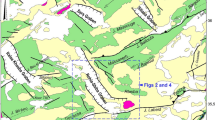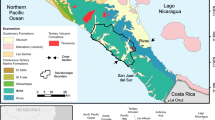Abstract
The Boone Formation has been generalized as a karst aquifer throughout northern Arkansas, although it is an impure limestone. Because the formation contains from 50 to 70 % insoluble chert, it is typically covered with a mantle of regolith, rocky clay, and soil which infills and masks its internal fast-flow pathways within the limestone facies. This paper describes continuous monitoring of precipitation, water levels in wells, and water levels in streams (stream stage) in Big Creek Valley upstream from its confluence with the Buffalo National River to characterize the nearly identical timing response of relevant components of the hydrologic budget and to clearly establish the karstic nature of this formation. Although the complete hydrographs of streams and wells are not identical in the study area, lag time between precipitation onset and water-level response in wells and streams is rapid and essentially indistinguishable from one another. The spikey nature of the stream hydrographs reflects low storage, high transmissivity, and rapid draining of the upper zones of the karst aquifer, whereas the longer-term, plateau-like draining in the lower zones reflects groundwater perching on chert layers that feed low-yield springs and seeps through lower storage and lower permeability flow paths. Groundwater drainage to thin terrace and alluvial deposits with intermediate hydraulic attributes overlying the Boone Formation also shows rapid drainage to Big Creek, consistent with karst hydrogeology, but with high precipitation peaks retarded by slower recession in the alluvial and terrace deposits as the stream peaks move downstream.
















Similar content being viewed by others
References
Adamski JC, Petersen JC, Freiwald DA, Davis JV (1995) Environmental and hydrologic setting of the Ozark Plateaus study unit, Arkansas, Kansas, Missouri, and Oklahoma: U.S. Geological Survey Water-Resources Investigations Report 94-4022
Aley T (1988) Complex radial flow of ground water in flat-lying residuum-mantled limestone in the Arkansas Ozarks. In: Proceedings of the second environmental problems in karst terranes and their solutions conference, Nashville, TN, November 16–18, 1988, vol 2, pp 159–170
Aley T, Aley C (1989) Delineation and characteristics of the recharge area for Mitch Hill Spring-Buffalo National River. Ozark Underground Laboratory, Protem, Missouri. [Final Report to the National Park System, Buffalo National River]
Big Creek Research and Extension Team (BCRET) (2015) Demonstrating and monitoring the sustainable management of nutrients on C&H Farm in Big Creek Watershed: quarterly report—April 1 to June 30, 2015: University of Arkansas System, Division of Agriculture
Braden AK, Ausbrooks SM (2003) Geologic map of the Mt. Judea quadrangle. Arkansas Geological Commission, Newton County, AR, scale 1:24,000, 1 sheet
Brahana V (2011) Ten relevant karst hydrogeologic insights gained from 15 years of in situ field studies at the Savoy Experimental Watershed. In: Kuniansky E (ed) U.S. Geological Survey Karst Interest Group proceedings, Fayetteville, AR, April 26–29, 2011: U.S. Geological Survey Scientific Investigations Report 2011-5031, pp 132–141
Brahana V (2012) Far-field tectonic factors of the Ouachita orogeny and their influence on the karst hydrogeology of the southern Ozarks; proceedings with abstracts, Geological Society of America annual meeting, vol 44, p 6
Brahana V, Nix J, Bitting C, Bitting C, Quick R, Murdoch J, Roland V, West A, Robertson S, Scarsdale G, North V (2014) CAFOs on karst–meaningful data collection to adequately define environmental risk, with a specific application from the southern Ozarks of northern Arkansas. U.S. Geological Survey Scientific Investigations Report 2014-5035, pp 87–96
Fanning BJ (1994) Geospeleologic analysis of karst and cave development within the Springfield Plateau of northwest Arkansas. University of Arkansas, unpublished M.S. thesis
Freeman MC, Carpenter MC, Rosenberry DO, Rousseau JP, Unger R, McLean JS (2004) Use of submersible pressure transducers in water-resources investigations, U.S. Geological Survey Techniques of Water Resources Investigations, Book 8, Chapter A3
Funkhouser JE, Little PR, Brahana JV, Kresse TM, Anderson M, Formica S, Huetter T (1999) Methodology to study the effects of animal production in mantled karst aquifers of the southern Ozarks. In: Palmer AN, Palmer MV, Sasowsky ID (eds) Karst modeling: special publication 5. Karst Waters Institute, Charles Town, pp 255–258
Gouzie D, Dodd R, White D (2010) Dye tracing studies in southwestern Missouri, USA: indication of stratigraphic flow control in the Burlington Limestone. Hydrogeol J 18(4):1043–1052
Gurian-Sherman D (2008) CAFOs uncovered—the untold costs of confined animal feeding operations. Union of Concerned Scientists, Cambridge, p 94
Hobza CM, Moffit DC, Goodwin DP, Kresse T, Fazio J, Brahana JV, Hays PD (2005) Ground-water quality near a swine waste lagoon in a mantled karst terrane in northwestern Arkansas. In: Kuniansky EL (2005) U.S. Geological Survey Karst Interest Group proceedings, Rapid City, South Dakota, September 12–15, 2005: U.S. Geological Survey Scientific Investigations Report 2005-5160, pp 155–162
Hudson MR (2000) Coordinated strike-slip and normal faulting in the southern Ozark dome of northern Arkansas: deformation in a late Paleozoic foreland. Geology 28:511–514
Imes JL, Emmett LF (1994) Geohydrology of the Ozark Plateaus aquifer system in parts of Missouri, Arkansas, Oklahoma, and Kansas. U.S. Geological Survey Professional Paper 1414-D
Kosic K, Bitting LC, Brahana JV, Bitting CJ (2015) Proposals for integrating karst aquifer evaluation methodologies into national environmental legislations. Sustain Water Resour Manag 1:263–374. doi:1-1007/s40899-015-0032-5. http://link.springer.com/article/10.1007/s40899-015-0032-5/fulltext.html. Accessed 25 Jan 2016
Leh MD, Chaubey I, Murdoch JF, Brahana JV, Haggard BE (2008) Delineating runoff processes and critical runoff source areas in a pasture hillslope of the Ozark Highlands. Hydrol Process. doi:10.1002/hyp7021
Liner JL (1979) Lithostratigraphy of the Boone Limestone (Lower Mississippian), northwest Arkansas. University of Arkansas, unpublished M.S. thesis
Mott D (2003) Delineation and characterization of karst ground water recharge in the vicinity of Davis Creek and John Eddings Cave, Buffalo National River, Arkansas. U.S. Dept. of Interior, National Park Service, Buffalo National River, Open-File Report of the Water Resource Division
Palmer AN (2007) Cave geology. Cave Books, Dayton, p 454
Pesta, Nathan, for DeHaan, Grabs, and Associates, LLC, and Geoffrey Bates and Associates, Inc. (2012) NPDES Notice of Intent (NOI) Concentrated Animal Feeding Operations ARG590000, C&H Hog Farms, SSection (sic) 26, T-15-N, R-20-E, Newton County, Arkansas: Unpublished document to Arkansas Department of Environmental Quality, Mandan, North Dakota. http://www.adeq.state.ar.us/downloads/webdatabases/permitsonline/npdes/permitinformation/arg590001_noi_20120625.pdf. Accessed 28 Jan 2015
Sauer VB, Turnipseed TP (2010) Stage measurement and gaging stations. U.S. Geological Survey Techniques and Methods Book 3, Chapter 7. http://pubs.usgs.gov/tm/tm3-a7/
Shuter E, Teasdale WE (1989) Application of drilling, coring, and sampling techniques to test holes and wells, U.S. Geological Survey Techniques of Water Resources Investigations, Book 2, Chapter F1
Straub TD, Parmar PS (1998) Comparison of rainfall records collected by different rain gage networks. In: Proceedings of the first federal interagency hydrologic modeling conference, Las Vegas, NV, pp 7.25–7.32
Taylor CJ, Alley WM (2001) Ground-water level monitoring and the importance of long-term water-level data, U.S. Geological Survey Circular 1217
Tennyson R, Terry J, Brahana V, Hays P, Pollock E (2008) Tectonic control of hypogene speleogenesis in the southern Ozarks–implications for NAWQA and beyond. U.S. Geological Survey Scientific Investigations Report 2008-5023, pp 37–46
Varnell CJ, Brahana JV (2003) Neuse River-impact of animal production on water quality. In: Stewart BA, Howell T (eds) The encyclopedia of water science. Marcel Dekker, New York, pp 622–624
Winter TC, Harvey JW, Franke OL, Alley WM (1998) Ground water and surface water A single resource. U.S. Geological Survey Circular 1139
Acknowledgments
We are most grateful to Patagonia Environmental Grants Program for funding a portion of travel expenses for this project, to the Buffalo River Watershed Alliance for maintenance of the Patagonia Award, to Ann Mesrobian, Ginny Masullo, and Marti Olesen for editorial and verification review, and to four anonymous donors who contributed funds for partial travel and equipment expenses. Three local landowners and farmers in Big Creek Valley allowed us access to their wells and unlimited access to their property, and we are most grateful for their assistance and kindness. Finally, we sincerely thank two anonymous peer reviewers for this journal who made meaningful suggestions that improved this paper.
Author information
Authors and Affiliations
Corresponding author
Additional information
John Murdoch: Retired from University of Arkansas, Department of Biologic and Agricultural Engineering, Fayetteville, Arkansas 72701, USA.
Rights and permissions
About this article
Cite this article
Murdoch, J., Bitting, C. & Van Brahana, J. Characterization of the karst hydrogeology of the Boone Formation in Big Creek Valley near Mt. Judea, Arkansas—documenting the close relation of groundwater and surface water. Environ Earth Sci 75, 1160 (2016). https://doi.org/10.1007/s12665-016-5981-y
Received:
Accepted:
Published:
DOI: https://doi.org/10.1007/s12665-016-5981-y




